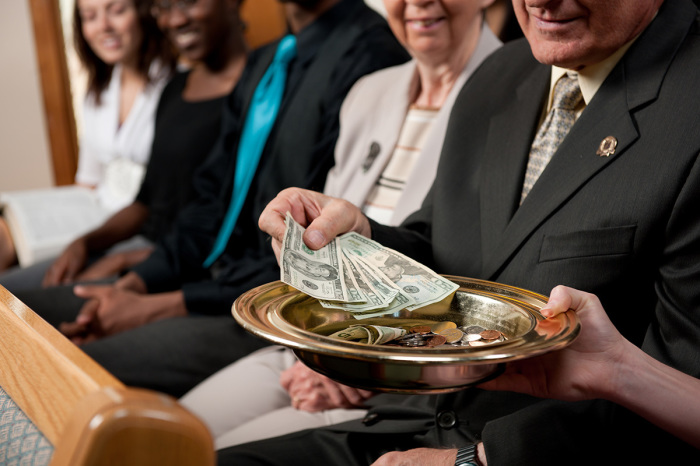Digital giving is growing but in-person giving remains dominant

Most Protestant churches in the United States continue to pass a plate or basket during worship services to collect offerings, according to a new survey of pastors by Lifeway Research, which found the traditional method remains far more common than digital giving or collection boxes.
Nearly three in four U.S. Protestant pastors say their churches collect physical offerings by passing something around during the service, and close to half say they also have giving options as people arrive or leave the building, the study found.
After surveying 1,003 Protestant pastors, Lifeway found that 64% use passing the plate as the primary collection method, more than any other option, with that number rising to 68% among pastors leading churches with 50 to 99 attendees.
Scott McConnell, executive director of Lifeway Research, said in a statement that the range of giving methods reflects the diversity of worship practices. “While many churches offer digital giving options, only 1% of churches say they don’t provide an opportunity to give an offering in person at their worship services.”
Denominational differences were evident.
Lutheran and Methodist pastors tied for the highest rates of passing the plate during services at 77%. That compares to 65% of Presbyterian or Reformed pastors, 64% of Baptist pastors, 61% of Pentecostal pastors, 43% of Restorationist movement pastors and 36% of non-denominational pastors.
Mainline pastors were more likely than Evangelical pastors to collect offerings by passing the plate, with 74% saying they do so compared to 60% of Evangelicals. Among racial groups, 76% of African American pastors use this method, compared to 63% of white pastors.
Ten percent of pastors say their congregations collect offerings by passing a plate or basket at the end of the service. This practice is more common among Baptist pastors at 15%, compared to 7% of Presbyterian-Reformed pastors and just 6% of Lutheran pastors. It is the least used among churches with fewer than 50 attendees, where only 6% said they pass plates at the end.
Some pastors prefer methods that do not interrupt the service.
Forty percent say their churches rely on collection boxes stationed at entrances and exits, making it the second most popular method. These boxes are more common among Evangelical pastors than Mainline pastors (45% versus 30%), and more frequently used in churches located in the West (48%).
Non-denominational churches lead this category, with 59% saying they provide boxes, followed by Baptist (43%), Pentecostal (41%), Presbyterian-Reformed (40%), Lutheran (32%), and Methodist (23%) pastors.
Younger pastors tend to favor collection boxes and end-of-service giving. Forty-six percent of pastors younger than 45 use boxes, and 20% hold plates or baskets at the doors as congregants leave. The end-of-service method is also more common among larger churches, with 25% of churches with 250 or more attendees and 20% of churches with 100 to 249 attendees using this practice, compared to just 11% of mid-sized churches and 12% of the smallest ones.
There’s no visible cue with collection boxes, McConnell said, referring to churches that use them exclusively or in tandem with other methods. “While some churches use the boxes in addition to other methods to make sure everyone has the chance to give, others use them exclusively to minimize guilt or pressure to give,” he added.
Only 2% of churches report using other methods to collect physical offerings. One percent of pastors say attendees bring their offerings to the front during the service, while another 1% say they leave an unattended plate or basket out. One percent of pastors were unsure how offerings are collected in their churches.
A 2022 Lifeway Research study of Protestant churchgoers showed that while digital giving was growing, in-person giving remained dominant.
Sixty-two percent of those who donate said they did not use any electronic method. The most common way to give was with cash, used by 53% of givers, followed by checks at 30%. Fewer contributed through the church website (23%), bank transactions (14%), automation (8%), a church app (7%), or via text (2%). About 9% said they mailed a check to the church.
McConnell noted that while online giving now brings in a significant share of total donations, most congregants still want to give physically when attending in person.
However, a 2020 study suggested that churches across denominations began shifting toward online giving during the COVID-19 lockdowns and bans on in-person worship, as many reported a decline in in-person offerings.
The Ministry Brands report “Coping with COVID-19: Insights from Church Leaders,” based on a survey of 1,400 church leaders conducted from July to September 2020, found that nearly 60% identified reduced giving income as a top challenge, with Catholic churches among the most affected — 67% reported concern over declining donations, which the report linked to the drop in physical attendance.

















